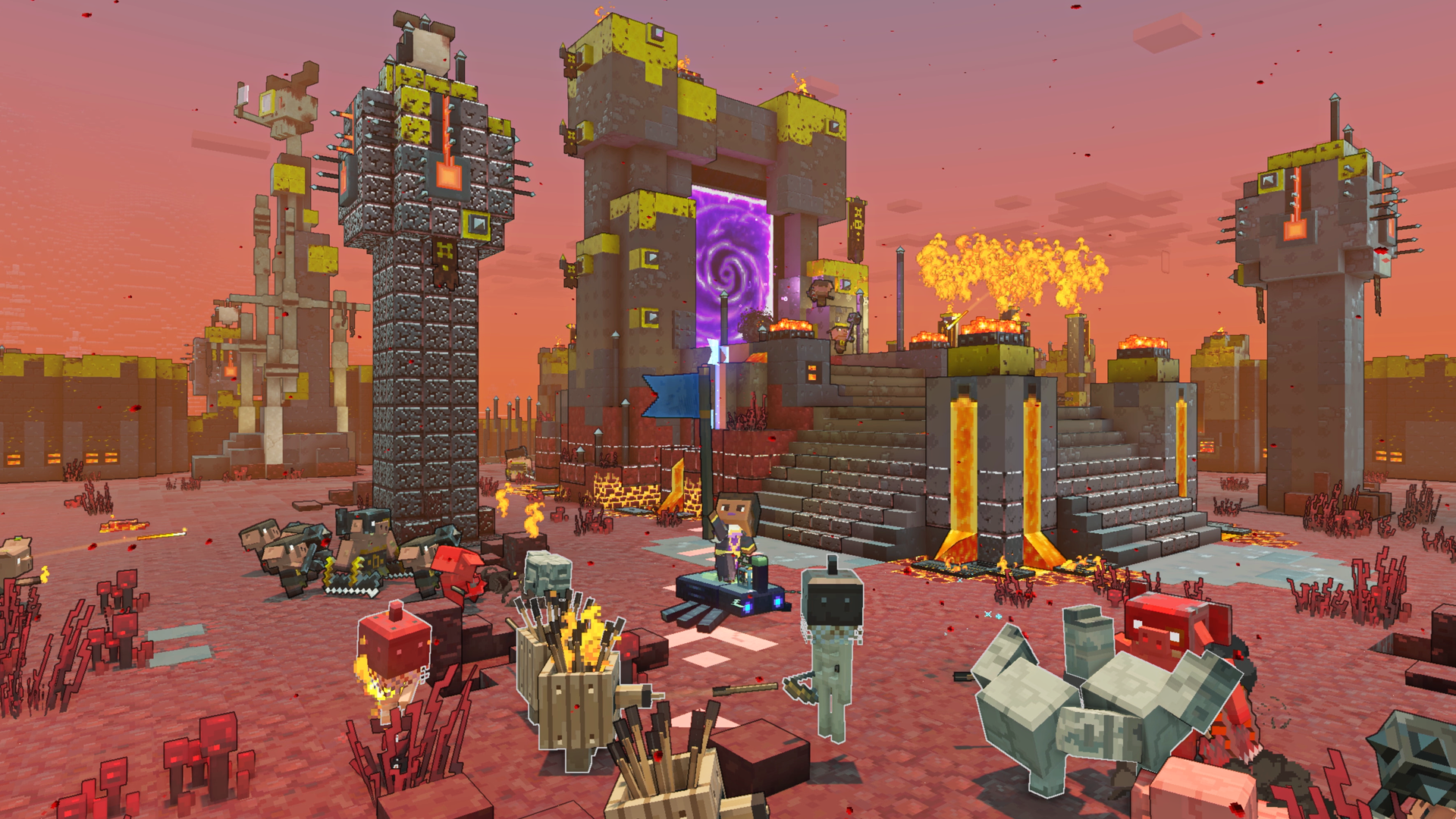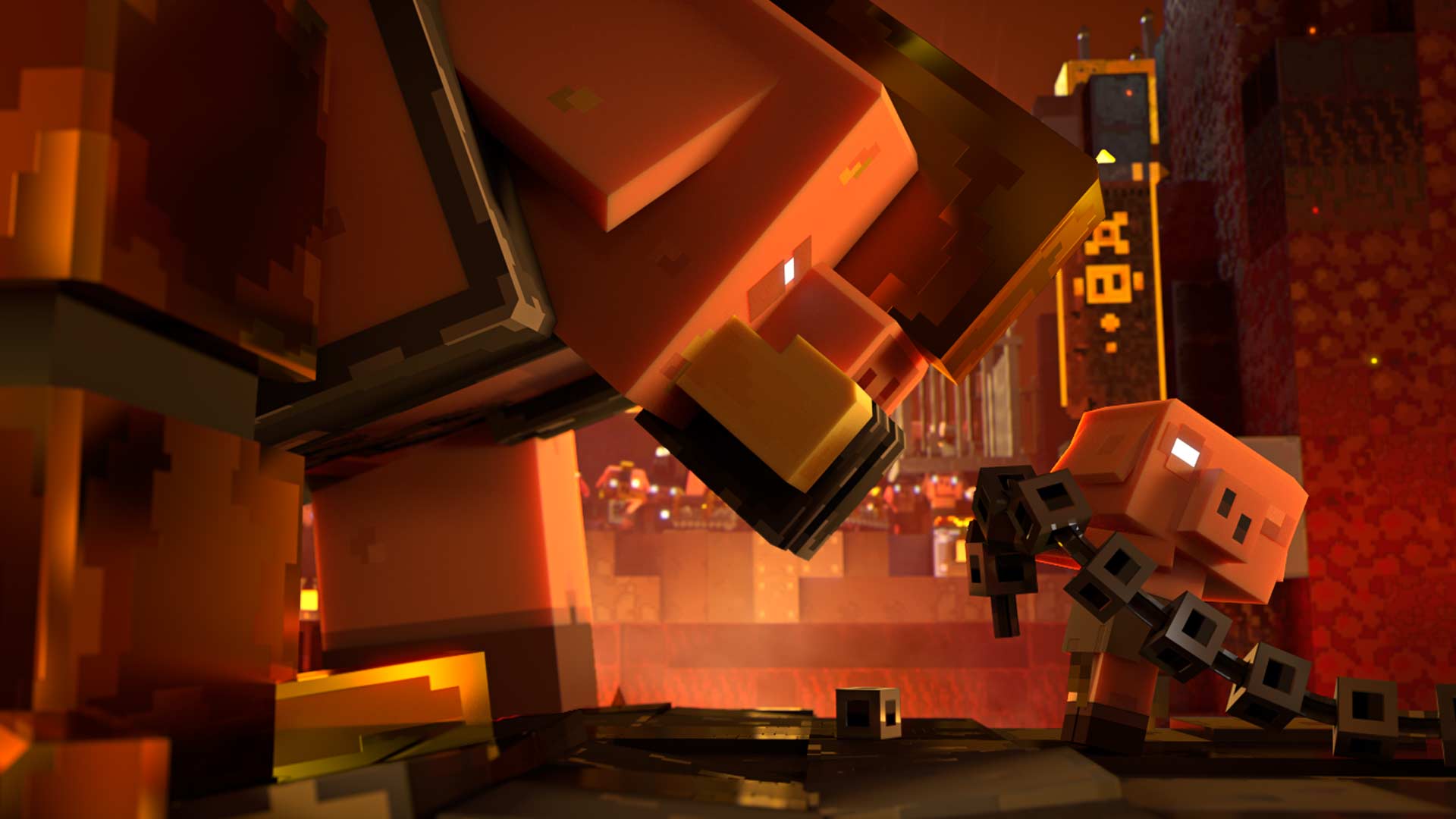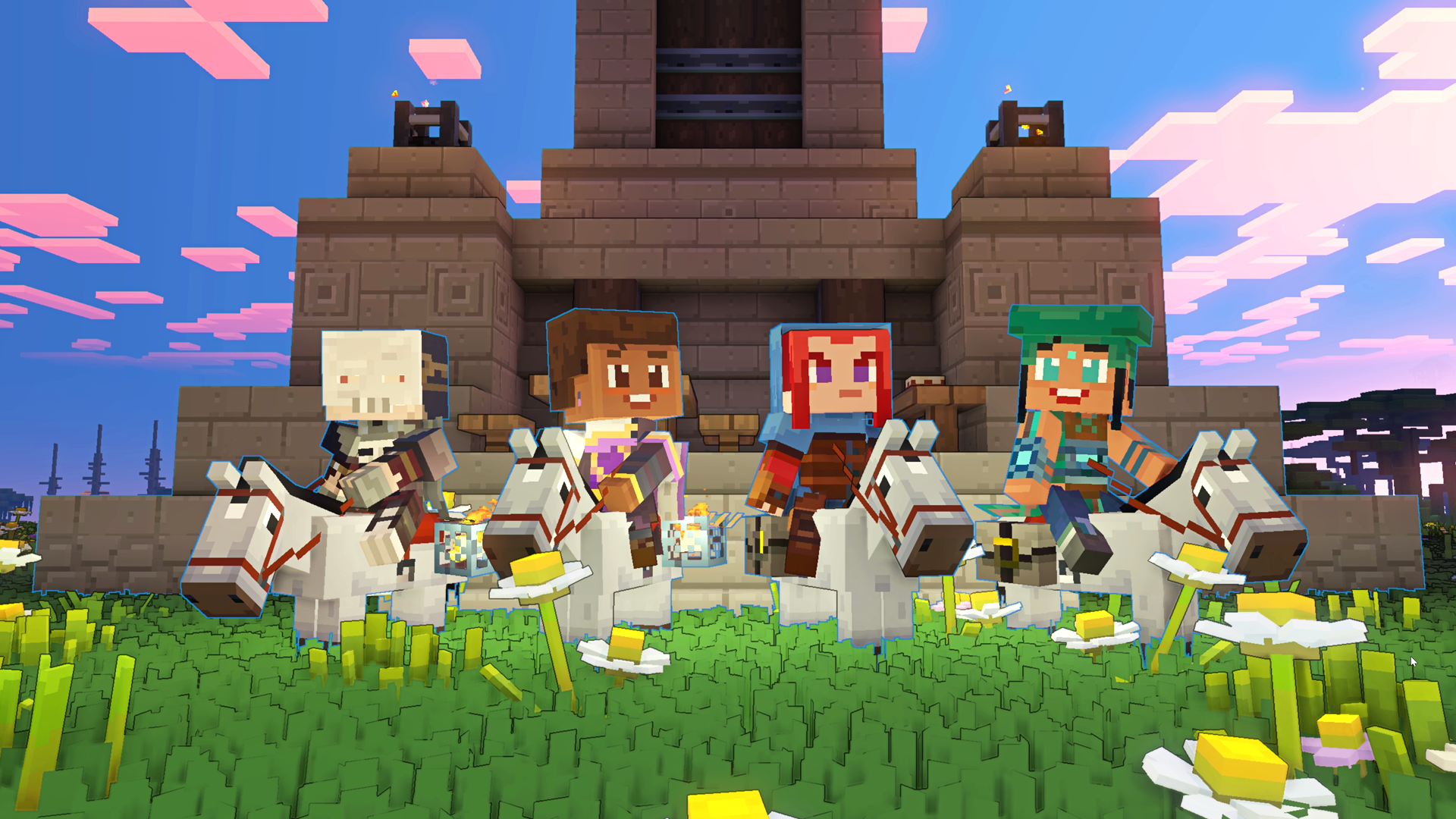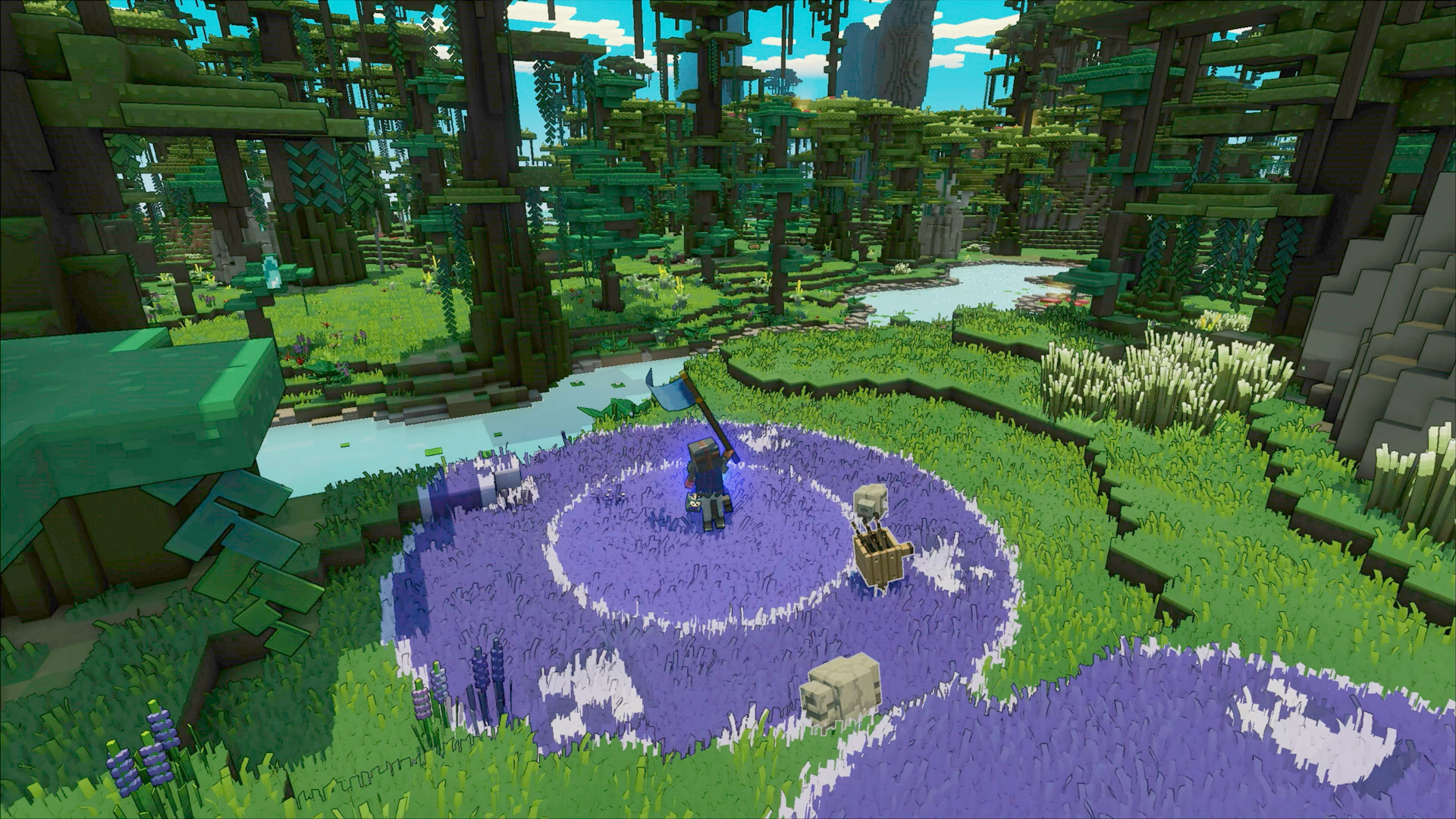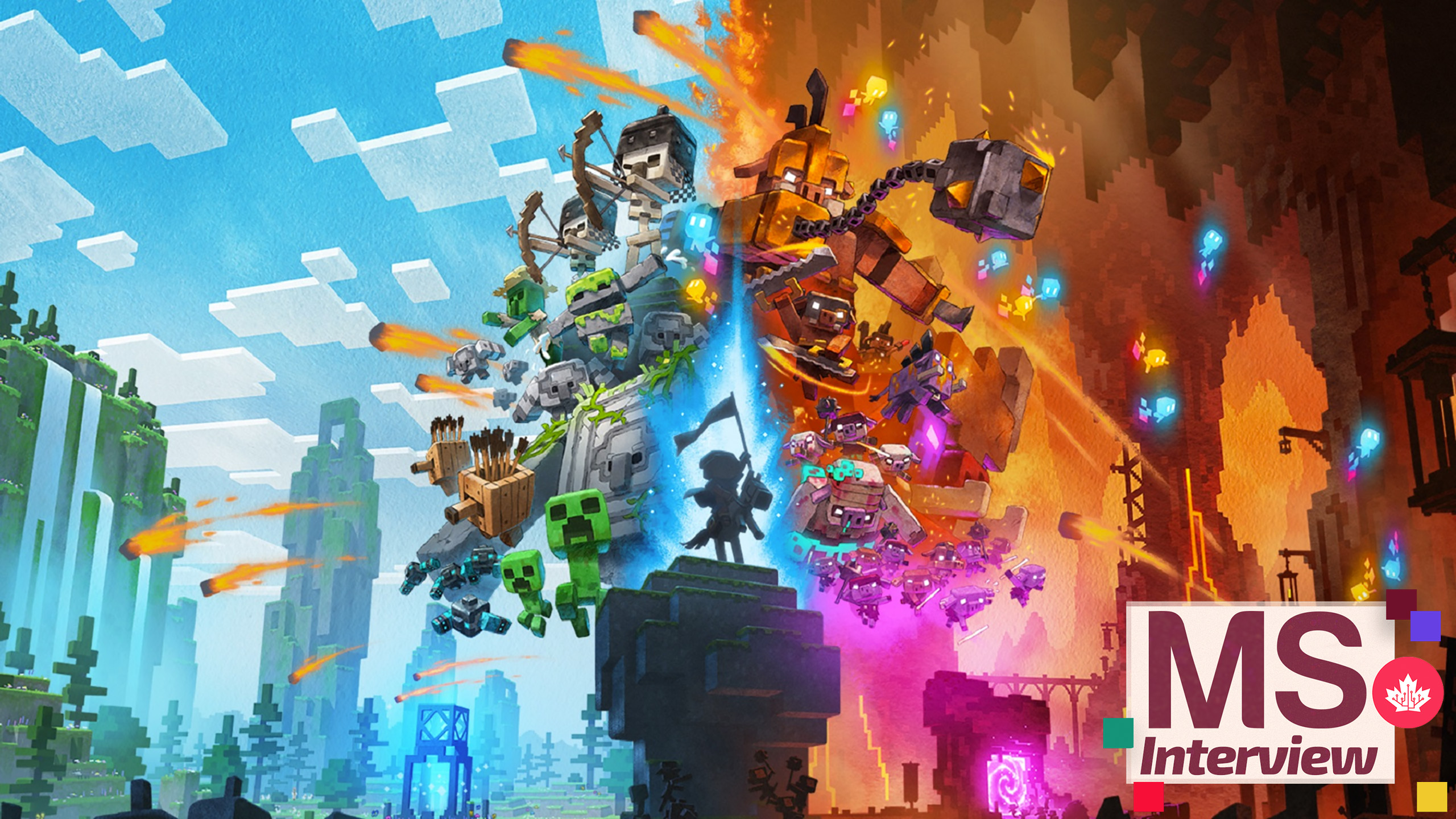
Since Microsoft acquired Minecraft in 2014, the beloved sandbox game has gotten a variety of spin-offs.
This includes the Telltale point-and-click adventure Minecraft: Story Mode, dungeon crawler Minecraft Dungeons and mobile augmented reality game Minecraft Earth.
Now, developer Mojang is taking the property even further with Minecraft Legends, an action-strategy experience. To bring the series into this more tactical space, Mojang has teamed up with Vancouver’s Blackbird Interactive, a studio consisting of strategy veterans from Relic Entertainment (Homeworld). In Legends, the player must unite the Overworld’s different factions to stop an invading Piglin threat.
MobileSyrup sat down with Dennis Ries, executive producer of Minecraft Legends at Mojang, and Lee Pederson, executive producer at Blackbird, to learn more about the game. Together, they discussed the collaboration between the two studios, introducing player vs. player (PvP) to Minecraft, offering a different perspective on Minecraft staples like Creepers and more.
Question: There have been a number of Minecraft spin-offs so far. How did you come up with the idea of an action-strategy one?
Dennis Ries: It really started with a small group of employees within Mojang sitting around talking about what type of genre would be really cool with Minecraft, and strategy kind of rose to the top. At that point, a group of us started going out and talking with different strategy developers trying to understand what type of experiences they would like to make for Minecraft. And Blackbird Interactive — that’s where Legends was born. And it was great because they really brought a kind of new, refreshing take on what what could be in Minecraft and it’s been exciting the whole way.
Q: Once you partnered with Blackbird, what did that collaboration look like, especially since you have Mojang teams in Stockholm and Redmond while Blackbird is in Vancouver?
Ries: That’s a great question because it makes me think way back. It started very small as you begin to try to understand what the concept is. And you have to find the timezone that works best. So fortunately, Mojang and Blackbird are in the same timezone, so we just sort of have to work earlier in the day, and then some of those things can continue in the afternoon if we’re just talking with Redmond. But the collaboration really started more on the creative side and as we got a little bit further down the pike, we started to see ‘oh, now we know we understand the technical route that we want to take.’ We are using the Bedrock Engine and that took a lot of collaboration with our Redmond counterparts; a lot development for Bedrock took place there at the time. And that grew bigger. It’s been a great partnership; it’s been fun to work with Blackbird. You might have an answer that’s completely contrary to me, Lee. [laughs]
Lee Pederson: No, not at all! It’s been amazing. Like Dennis said, it was a pretty small team to start. I’ve been on the project for almost five years — it spun off at the beginning of 2018. I started five months, maybe, after that initial group of two or three people. So I’ve been there, as has Dennis, the whole journey, which has been remarkable. So, a small team really collaborating on the creative. We were given a lot of room to collaborate with the Mojang team, both in Stockholm and in Redmond, which was amazing. It wasn’t like, ‘this is this is exactly what you need to make and here’s exactly how you go ahead and do it.’ There was a lot of back and forth. I think that really shows in the art style of Legends — that collaboration and where it led. It’s a really beautiful game that’s really distinct from Minecraft, but you can really get the Minecraft feeling from it. So I think we brought a lot of the team’s passion for strategy, and our background in strategy and our love of Minecraft. Working with our partners and in both in Stockholm and Redmond — I think we really developed a beautiful product.
Q: One of the things that’s interesting about Legends is it’s not really fact or fiction; it’s just these stories that are told within the Minecraft universe. How did you land on this idea and balance creating something that still feels like Minecraft but takes a bit more creative liberty and plays a bit loose with canon?
Ries: What’s great is we have a narrative director within Mojang named Kevin Grace. And when we think about how to tell the story, we understand all players have their own stories, right? And this is just a story in the Minecraft universe. And I think that was an important part. We’re not out to set some sort of official story for what Minecraft should be. It’s more about letting the players have that journey. So that was how we approached it, and I think that was an important perspective that we brought to the game.
Q: How did Blackbird’s previous experiences on strategy games inform your approach to Legends?
Pederson: While we have a background in strategy and a lot of us have a background in hardcore real-time strategy (RTS), I think we approached this with Mojang less with a rigid framework around ‘we want this to be an RTS.’ We were more like, ‘what are the elements of strategy that we can bring to this that also makes sense within the Minecraft universe, makes sense with the genre we’re aiming for with the action-strategy with your hero within it, and how can we layer that in rather than trying to force a more rigid RTS framework from within Minecraft?’
Ries: One element I will say, from a Mojang perspective, that really impressed us with Blackbird was their knowledge of Minecraft. There’s so much to Minecraft. Even working here, I learn new stuff about it every day, and it’s awesome. But that depth of experience really came to fruition as they would start creating these concepts and bringing them out and trying to explain how they take the strategy experience, and make it a Minecraft strategy game and not a strategy game with Minecraft in it. So it was really fun.
Q: On that note — Lee, what was it like for Blackbird to come in with a love of Minecraft and get to work on a new Minecraft game?
Pederson: It was pretty scary, I have to admit. This is such a huge responsibility. It’s such a big game. It’s such a big team. This is the biggest game that [Blackbird] has ever worked on. So just taking on that responsibility is a big mantle and we wanted to make sure that we were bringing our love of Minecraft and our passion and that we were aligning with the creative vision… So certainly, it’s a bit of a scary thing to take on. Because the community is so big, the love of Minecraft is so, so expansive and wide-reaching, that we wanted to make sure that we absolutely brought our A-game all the time. We want this to be a game that the community loves and embraces and builds on and creates legends on top of what we are building.
Q: Legends is the first time PvP has ever been an official mode in a Minecraft game. How did you decide on Legends being the right time and place for it?
Ries: It was actually early in prototype as we started to sort of think about this action-strategy component in a PvP environment. We created a fun experience — it was like this ‘chaotic fun’ and unlike something we’d seen before in the games that we played. And so we were like, ‘well, let’s explore this further. This could be something special.’ And so we kept at it. And we’ve run into some complex situations; balancing can be difficult with a procedurally-generated multiplayer game. And how do we solve problems to make sure players understand what to do? So for us, how did it start? Well, it started because we had this prototype experience that was just a ton of fun. And then we just kept pushing and got to a point where like, ‘Yeah, this is something we really want to support at retail and let players experience.’
Pederson: And I think we’ve also collectively really focused on campaign and PvP as being two distinct modes that have been moving forward — not in lockstep, necessarily, but we’ve been progressing on and tuning and moving forward on them rather than PvP being a sort of secondary game mode. We’ve really pushed on all fronts on those and really focused on both campaign and PvP.
Q: One of the official Legends videos said there’s less on an emphasis on “fair,” per se, and more on the “chaotic fun” you mentioned. You obviously don’t want it to completely unbalanced and broken, but you do want to keep it loose and chaotic. How do you toe that line?
Pederson: When we’re creating the PvP worlds, we’re making the worlds much smaller than we are in campaigns. So, in campaign, it’s really about exploration and uniting the overworld and the Piglin hordes and approaching battle. Whereas in PvP, it’s a much shorter experience — we’re hoping it’s a 20- to 30-minute experience for each team, each game. So we’ve made the world much more compact, so that you are within a distance of your opponent’s HQ; you’re not having to traverse territory for 30 minutes to try to find where the opponents are. So it’s a small world.
We balanced the resources differently. So there’s more stone, there’s more wood, there’s a different distribution of resources, so that you can leverage your strategy, whether you’re going for an iron strategy, or a diamond strategy, whatever it might be. There’s just a different resource allocation within the world. Because it is procedurally generated, it’s not always going to be the same thing every single time — you’re not always going to find the same balance of resources in every biome, whatever it might be. There are elements of chance within that, but we’ve tuned certain elements of it to make the experience where you’re focused on resourcing and building out your base and attacking your opponent’s team rather than having to traipse around because you can’t find any trees to get any wood.
Ries: And while it may not be perfectly ‘fair,’ which is what I think the comment was from the video you may have seen, it’s interesting to see… sometimes a base may be generated in a less advantageous position than another base, but maybe that base has more beneficial resources closer to the base. And so it’s sort of a trade-off scenario. And the real interesting part is, even though it may not be perfectly fair, it doesn’t feel like it’s not perfectly fair. It feels fair every time. So it’s interesting and it’s worked out pretty well.
Pederson: And then it’s interesting how the procedurally-generated world informs your strategy because you have to react to what’s around you, and where you and where your opponents are.
Q: You’ve mentioned how you want this to be your own unique take on PvP. Besides the procedural generation, what are some of the ways that you’ve done that?
Ries: Taking things from the campaign, which is already unique enough, and then transitioning them to PvP. For example, you collect resources quicker. Also, you do share resources with your teammates, so that takes a lot of cooperation and effort to do — that’s definitely a unique element of the game. Then you take this action-strategy component where you can go off, if you wish, and have combat with another person in the map. That’s fun. Or you can take a strategy where you’re taking a Creeper and very pinpointedly directing the Creeper to go and try to blow up a very specific section of the person’s base. So there’s a lot of unique elements to PvP here I think that we tried to introduce but still stay true to a strategy element.
Pederson: There’s some components from the campaign, but they’re unlocked for the player or given to the player in different ways. They’re able to be acquired or battled for in different ways, which again, adds to the kind of layer of strategy. Like, you can create a Redstone Launcher because you’ve gathered enough resources to create that and potentially hide that behind a mountain and then surprise your opponents and destroy their HQ without them even knowing that that’s what you’ve done.
Q: On the flip side, can you talk a bit about how the cooperative multiplayer work?
Pederson: In the campaign, you can have up to four people in co-op. In that scenario, every single person could be attacking the same base, or you could be attacking different bases, or you could be wandering around resourcing. It’s a different experience in that you’re not necessarily having to all work together for a strategy, which is what PvP is about. You can drop-in and drop-out and help or not help. You can just sort of experience the world and explore and unlock mounts or help in that way, but you don’t necessarily all have to be banding together to handle different areas of the resource gathering defence/offence for a single kind of time-sensitive goal.
Q: Another interesting element of Legends is that you have Minecraft staples like Creepers, which used to be hostile, and now you can command them. When you were making Legends, how did you decide which existing parts of Minecraft that players know as one thing to reintroduce in a different way?
Ries: Yeah, that was fun for us because the idea of taking a Creeper and making them your friend was really foreign to us. And the same is true for the other mobs like the skeletons and zombies. So we just wanted to make sure that the behaviours of the Creeper were the same. So we didn’t want to suddenly have a creeper shoot arrows. And so once we got past the thought of, ‘we’re going to go with the strategy experience and we’re going to take something iconic like the Creeper and make it your friend, and that’s going to be the mobs that help defend the Overworld because everyone needs to work together here,’ then it became just making sure that we’re staying true to what Minecraft is. But the exciting part for us was creatively accepting that Creepers are not an enemy and that was definitely a fun thing to do.
Pederson: Yeah, our zombies have to wear hats, right? But they’re your friends. So it’s within the [Minecraft] framework, but also it’s a legend, so this is how we unite to defend the Overworld and push back the Piglins.
Q: That’s definitely part of the appeal for returning players. But part of tackling a new genre like this is you can bring in new players as well. So for those who haven’t played Minecraft, or maybe just haven’t in a long time, how is Legends inviting and approachable?
Ries: I think it’s very approachable. One of the things we really wanted to make sure is that even if you don’t know what Minecraft is, you still enjoy playing this game. So it’s not like you need to know Minecraft. So you can get in, you can explore the world — just the act of exploring is fun. And it feels fun to run through the world, it feels fun to find a mount and fly through the world or a tiger and just jump and go really far. You find these things. That was definitely fun and that helps it be approachable and kind of draws you in. You learn about the world and then you start to understand how the mobs can help you and that these Piglins are horrible things and you need to fight them and send them back. And it’s this element of easing the player into it that I think [Blackbird] actually did a really great job on.
Pederson: Because it has elements of strategy, it’s a little more complicated than just being able to pick up a very easy game and play it, but we do want to make it approachable. It isn’t extremely RTS, UI heavy, tech trees, etc. So while it’s probably a little more complicated than a kids game, we do have a good onboarding tutorial and first-time user experience. In the campaign, you’re not having to go in and immediately engage with a Piglin base. You can spend as much time as you want exploring around the edges of those and unlocking mounts like Dennis was talking about or engaging with the mobs and bringing them over to your side. So there’s things that you can do if you’re not feeling like you’re ready for the battle yet to get yourself more acclimated. But the experience, both PvP and campaign, is meant to be approachable for a broad range of players.
This interview has been edited for language and clarity.
Minecraft Legends will launch on April 18th, 2023 on Xbox consoles (plus Xbox Game Pass), PlayStation 4/5, Nintendo Switch, PlayStation 4 and PC.
Image credit: Xbox
MobileSyrup may earn a commission from purchases made via our links, which helps fund the journalism we provide free on our website. These links do not influence our editorial content. Support us here.

